2025.4 Time to continue the dashboards!
Home Assistant 2025.4! 🎉
It’s April 2nd, so this is definitely not an April Fool’s joke! 😃
But before diving into this month’s release, I want to quickly highlight something you might have missed—something I’m extremely excited about:
The State of the Open Home 2025!
Yes, you read that right! On Saturday, April 12th, 2025, we’ll be
streaming a big live event on YouTube
Alright, back to the release! As I was saying, it’s April already, and we have another fantastic release lined up for you.
The big news is the introduction of our new experimental Areas dashboard, which might evolve to become the default dashboard in the future. If you’re like me—not really a UI-oriented person—you’re going to love this one! 🤩
My personal absolute favorite feature this month is something I’ve dreamed of ever since we started working on voice assistants: the ability for your assistant to start a conversation proactively! This is a game changer—no other voice assistant on the market can do this! I’m going to have so much fun with this. 😃
If you’re a power user who loves templates, don’t worry—we’ve got you covered too! This release ships with a bunch of new template functions, making your life a lot easier.
Enjoy the release!
../Frenck
- Dashboards
- Voice
- Onboarding with a Home Assistant Cloud backup
- Integrations
- Other noteworthy changes
- Templates
- Device hierarchy for energy management
- Patch releases
- Need help? Join the community!
- Backward-incompatible changes
- All changes
Dashboards
We’re making dashboards smarter—automagically!
Dashboards allow you to monitor and control different aspects of your home. They are one of the main interfaces for interacting with Home Assistant, and a key contributor to what we call the Home Approval Factor—how useful and welcoming your smart home feels to everyone who lives in it.
Over the past year, we have focused on making dashboards easier to create and customize. We introduced the powerful drag-and-drop sections view and plenty of new tile card features.
We’re going a step further by delivering a dashboard that’s immediately relevant, saving you time and effort while still leaving room for personal touches.
A new experimental Areas dashboard
Until now, our default dashboard has served as a simple starting point—a list
of entitiesAn entity represents a sensor, actor, or function in Home Assistant. Entities are used to monitor physical properties or to control other entities. An entity is usually part of a device or a service. [Learn more] grouped by areaAn area in Home Assistant is a logical grouping of devices and entities that are meant to match areas (or rooms) in the physical world: your home. For example, the living room area groups devices and entities in your living room. [Learn more] or deviceA device is a model representing a physical or logical unit that contains entities.
domainsEach integration in Home Assistant has a unique identifier: The domain. It is often shown as the first part (before the dot) of entity IDs.. While helpful for beginners, it quickly becomes limited as
a smart home grows. We’ve learned that while some users enjoy building their
own dashboards, many simply want something that works for their household.
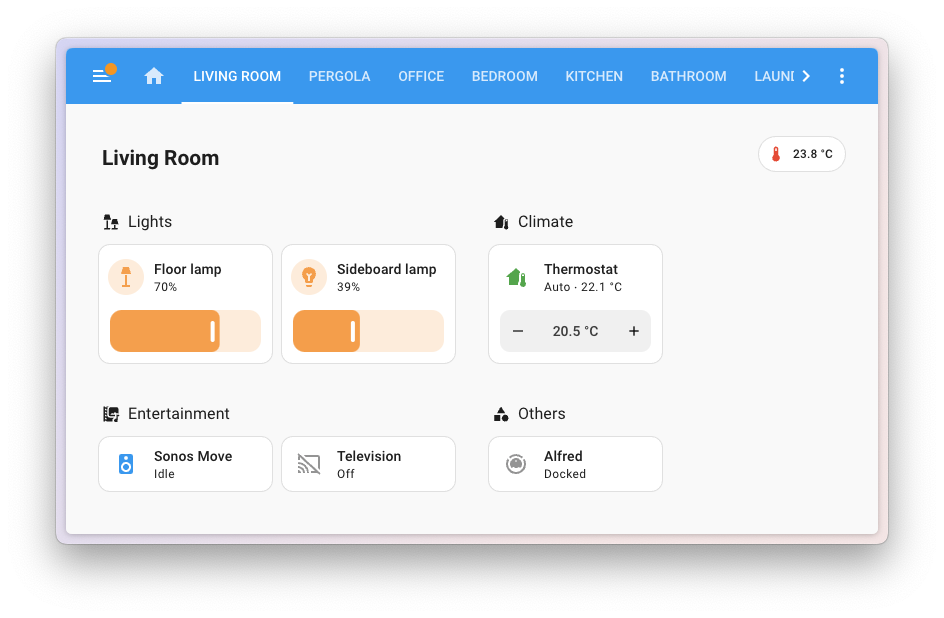
The new experimental Areas dashboard automatically generates a ready-to-use dashboard based on the areas you’ve set up in your home. It uses sections and tile cards for a modern, clean, and intuitive look—instantly. No more starting from a blank slate!
Each area now has its own dedicated page, giving you a clear and organized view of the devices in that space. Entities, such as lights, covers, cameras, and more, are automatically grouped by domain so you can easily locate the ones you need.
Want to tweak it? Yes, you can! You can rearrange, show, or hide entities to suit your preferences. At the top of each area page, temperature and humidity badges quickly indicate room comfort levels, which are configurable in the area’s settings.
On top of all that, the Overview page brings it all together, showing all your areas in one place. Each section corresponds to a room in your home, and just like with the area pages, you can rearrange, show, or hide areas here as well, based on your preferences.
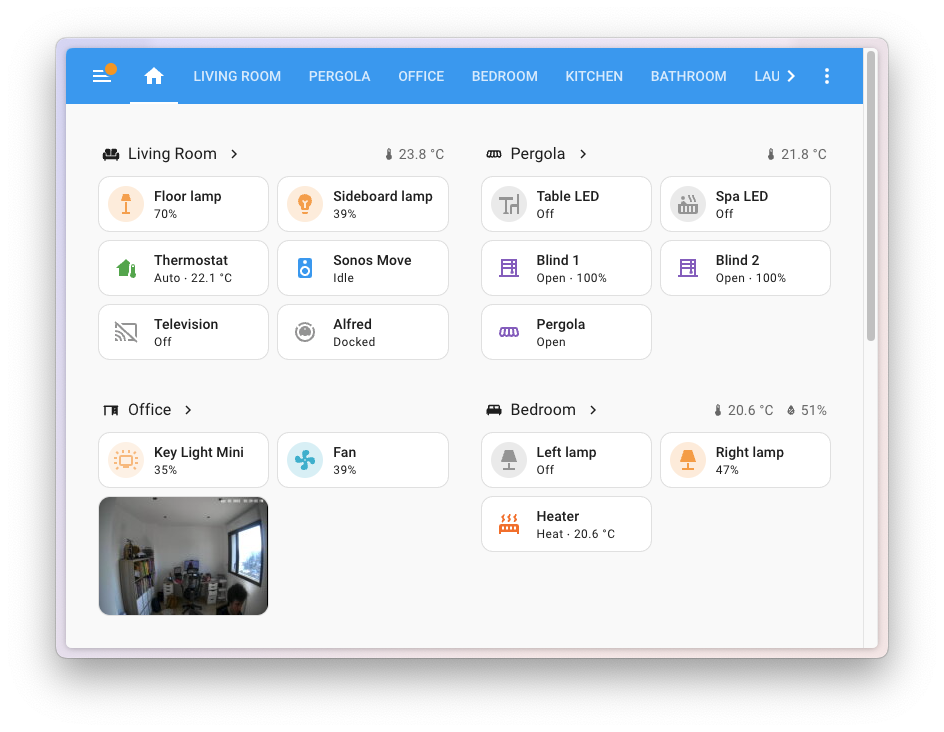
If you haven’t organized your devices into areas yet, now’s the perfect time to start—it’s key to unlocking this new dashboard experience. To get started with the Areas dashboard, go to Settings > Dashboards, and select Add Dashboard in the bottom right, next select the Areas (experimental) option from the dialog:
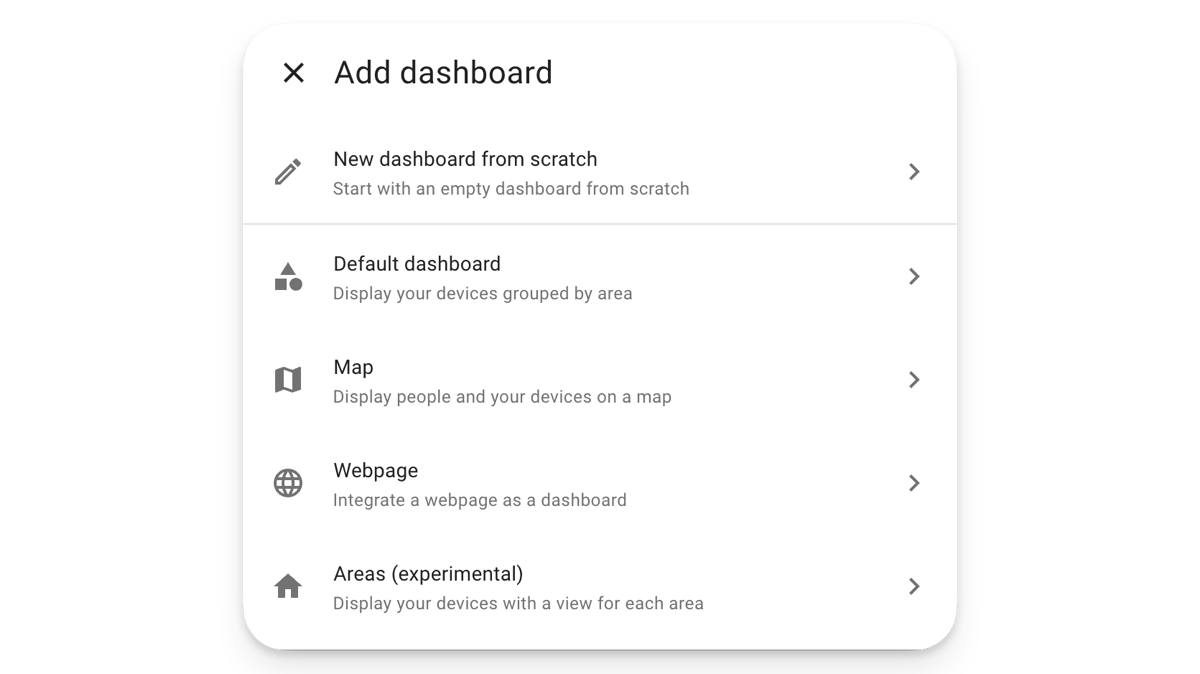
The new experimental Areas dashboard previews what’s to come. We’ve learned from our users that they organize their homes in different ways—by rooms, by function, by device, and more. They often combine all of the above, and therefore, our upcoming default dashboard will accommodate all these methods of organization.
Over time, this foundation will grow into a flexible system that adapts to your priorities, whether that’s keeping an eye on security, managing energy use, going through your family calendar and chores, learning about the weather, or simply watching your pets.
Please note that this is experimental, meaning it is subject to change and may not always work as intended. We would love your feedback if you notice some aspects we can improve. The community’s dashboards, shared over the years, have helped shape this design, and we would love to see how it works with a wide variety of your homes. Even if you already have the perfect dashboard built for your home, try it!
Update: We had a feedback form in the release notes in this spot, but that’s closed now. Thanks for your input!
Time for a new card!
It has been a while since we introduced a new card, but this release, we
thought it might be time to add a new one! Thanks to @mrdarrengriffin
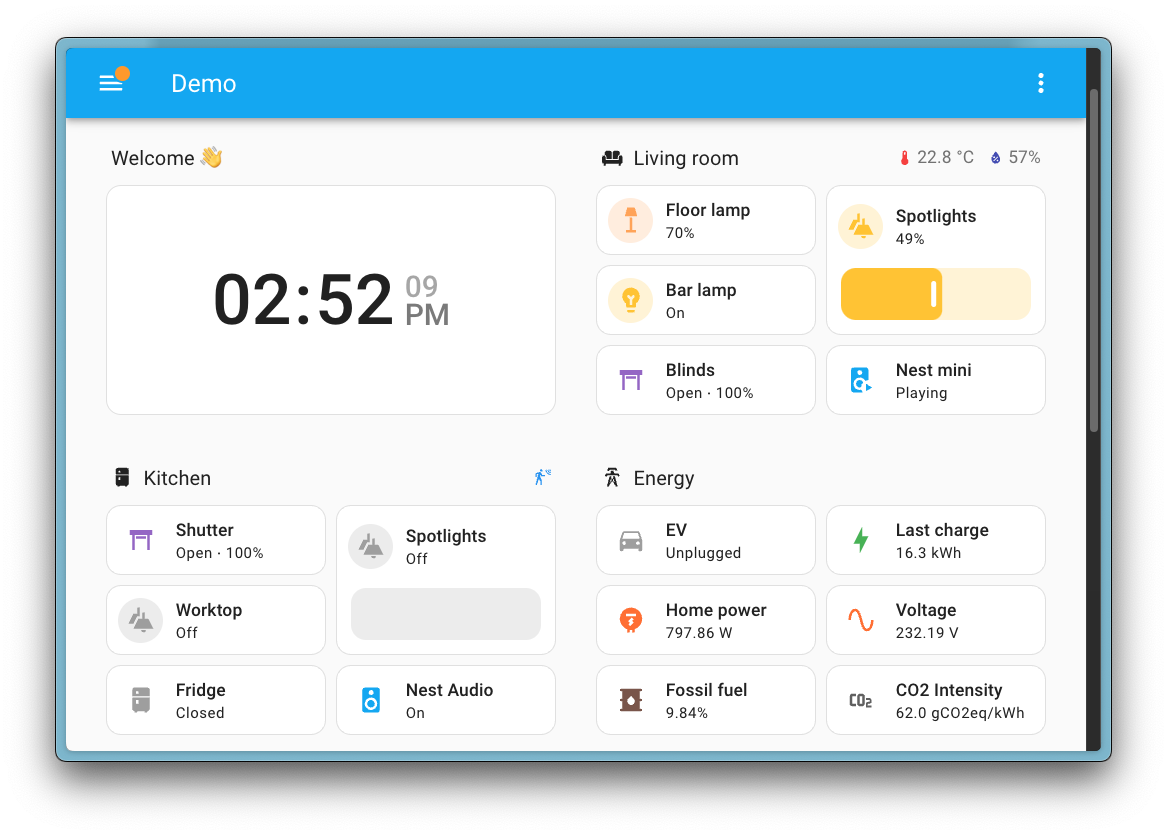
Yeah, the card is “just” showing the current time, but it is a really nice addition to our card collection. It might be a great card for dashboards you are showing on things like a wall-mounted tablet!
The Clock card offers several customization options, including the ability to adjust the clock size, timezone, display the seconds alongside the hours and minutes, and the ability to choose between a 12-hour or 24-hour format.
For more details, check out the Clock card documentation.
Voice
The “year of the voice” might be behind us, but we keep improving the voice experience in Home Assistant! This release brings several enhancements to make interacting with your smart home even better.
Improved Voice Wizard
If you set up a Home Assistant voice assistant compatible device, like the Home Assistant Voice Preview Edition, you will be guided through setting up your voice assistant, and this experience has been greatly improved in this release.
As our voice experience is offering more choices, including local options like Speech-to-Phrase, we wanted to make sure you are able to make the right choices for your use case.
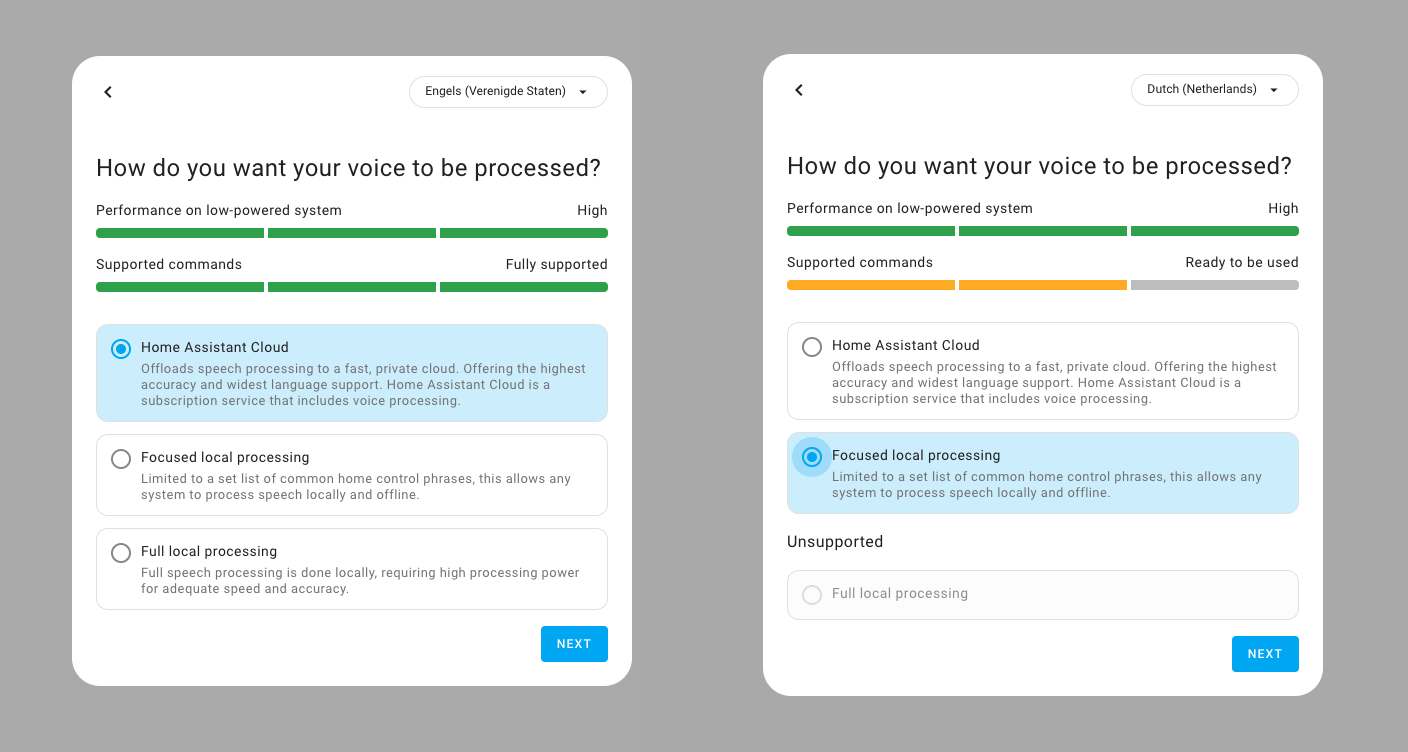
The wizard will now help you make a more informed decision based on your language, desired functionality, and device capabilities, ensuring you get the best experience with your voice assistant.
Continued conversation with LLMs
Ever tried to have a conversation with your voice assistant that is hooked up to an LLM like ChatGPT? It’s good fun. However, having to say “Ok Nabu”, whenever you answer one of Assist’s questions can really slow things down.
This release introduces the ability to have a continued conversation with LLMs. If the LLM returns with a question, we will detect that and keep the conversation going, without the need for you to say “Ok Nabu” again.
This is a great way to have a more natural conversation with your voice assistants, and it works with all LLMs supported by Home Assistant.
Starting conversations
During Voice chapter 9
This is a fantastic feature, as it allows you to build your own automations that can send out voice prompts from your voice assistant and listen for a response, instead of you having to trigger the conversation by saying the wake word.
Imagine, for example, you have left the garage door open, and a few minutes later, your assistant says:
Hey, I noticed you left the garage door open, do you want me to close it for you?
You simply reply “yes” or “no,” and it handles the rest… 🤯 Or perhaps after a long day at work, you return home, and your assistant greets you warmly:
Welcome home, Frenck! Hope you had a great day. Want to hear the news or maybe enjoy some music?
JLo made a great demo video of this one, involving his oven and the assistant asking if he wants to set a timer:
This opens up a whole new world of possibilities for voice-driven automations. Currently, this capability is only available when using LLM integrations, but we’re exploring more use cases where it would be helpful.
If you listen closely to the demo above, you’ll notice a brief pre-announce sound just before the conversation starts. This little notification prevents your assistant from startling anyone by suddenly speaking out of nowhere and preventing a jump scare! 🫣
You could even use custom sounds based on the scenario—like a doorbell chime for visitors or a train station-style jingle when your morning commute gets delayed, giving you extra time to grab that coffee before heading out. ☕
Onboarding with a Home Assistant Cloud backup
If you are a user of Home Assistant Cloud by Nabu Casa
Now, let’s say something did happen, maybe a hardware failure, or maybe you are migrating to a new Home Assistant Green, as of this release, you can directly restore your backup from the Home Assistant Cloud during the onboarding process of your new Home Assistant installation.
This means you can get up and running with your new Home Assistant installation in no time, with all your settings, automations, and integrations restored from your backup.
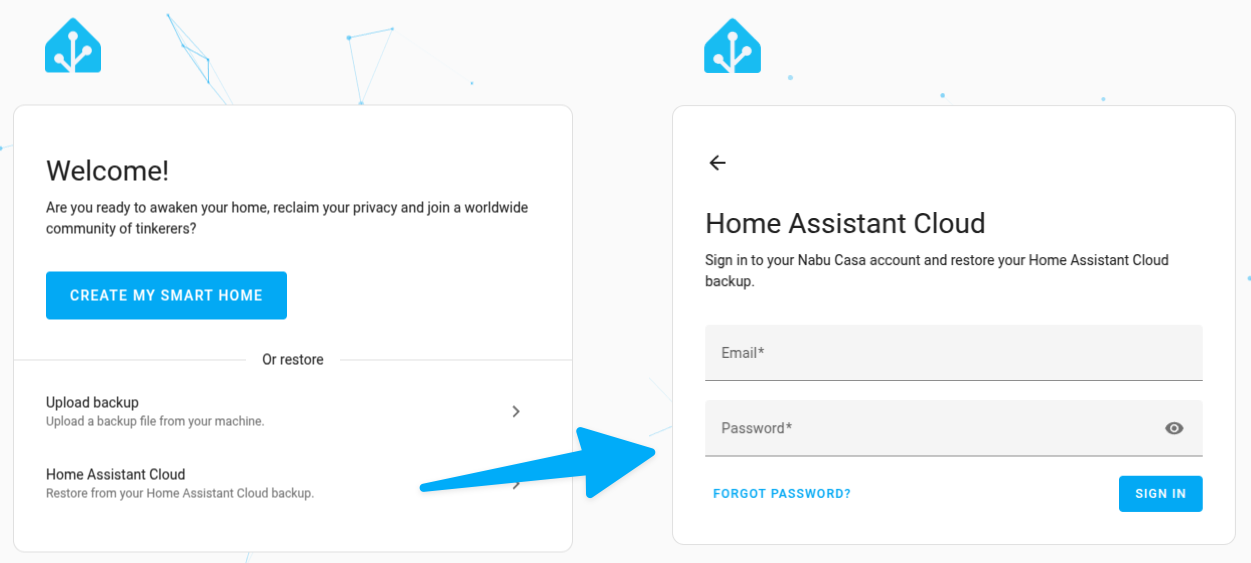
Integrations
Thanks to our community for keeping pace with the new integrationsIntegrations connect and integrate Home Assistant with your devices, services, and more. [Learn more] and improvements to existing ones! You’re all awesome 🥰
New integrations
We welcome the following new integrations in this release:
-
Bosch Alarm, added by @sanjay900
Control and monitor your Bosch intrusion alarm systems / control panels. -
Remote calendar, added by @Thomas55555
Add remote calendar URLs as a calendar to Home Assistant. -
Pterodactyl, added by @elmurato
Control and monitor your Pterodactyl game server management panel.
This release also has new virtual integrations. Virtual integrations are stubs that are handled by other (existing) integrations to help with findability. These ones are new:
-
FrankEver, provided by Shelly, added by @bieniu
-
LinkedGo, provided by Shelly, added by @bieniu
-
Ogemray, provided by Shelly, added by @bieniu
Noteworthy improvements to existing integrations
It is not just new integrationsIntegrations connect and integrate Home Assistant with your devices, services, and more. [Learn more] that have been added; existing integrations are also being constantly improved. Here are some of the noteworthy changes to existing integrations:
- The OpenAI conversation integration has a new action to generate content,
thanks to @timlaing
, and it can now search the web! Nice @Shulyaka ! - The Google AI conversation integration also gained the ability to search the
web, just like the above OpenAI one. Thanks @tronikos
! -
@joostlek
has absolutely been rocking the SmartThings integration! The list of improvements is extremely long, but it includes support for firmware updates through Home Assistant, support for event entities, PM0.1 sensors, washer rinse cycle settings, TV and media player support, and improved device handling. Awesome work there! - Not only SmartThings is receiving love, @Diegorro98
has been constantly at work improving and tuning the Home Connect integration. Thank you so much! - The Roborock integration has been extended to support dryer controls and button
entities to start routines. Thanks @Lash-L
and @regevbr ! -
Reolink cannot be left out of this list. This release adds support for their
smart AI sensors, and adds a day/night state sensor. Nice work @starkillerOG
! -
@tr4nt0r
extended the actions Habitica integration with lots of new and improved actions to manage your habits, rewards, and dailies. Thanks! - The Microsoft OneDrive integration has a new action that allows you to
upload files to OneDrive. Nice @zweckj
! -
@andrewsayre
extended HEOS with support for browsing media, allowing you to browse things like TuneIn and play them on your HEOS devices.
Integration quality scale achievements
One thing we are incredibly proud of in Home Assistant is our integration quality scale. This scale helps us and our contributors to ensure integrations are of high quality, maintainable, and provide the best possible user experience.
This release, we celebrate several integrationsIntegrations connect and integrate Home Assistant with your devices, services, and more. [Learn more] that have improved their quality scale:
-
4 integrations reached platinum 🏆
-
2 integrations reached silver 🥈
-
Roborock, thanks to @Lash-L
-
Vodafone Station, thanks to @chemelli74
-
Roborock, thanks to @Lash-L
This is a huge achievement for these integrations and their maintainers. The effort and dedication required to reach these quality levels is significant, as it involves extensive testing, documentation, error handling, and often complete rewrites of parts of the integration.
A big thank you to all the contributors involved! 👏
Other noteworthy changes
There are many more improvements in this release; here are some of the other noteworthy changes this release:
- The Home Assistant Yellow Zigbee/Thread chip and Home Assistant ZBT-1
can now be updated directly through Home Assistant update entities.
Nice @puddly
! - When viewing the details of an entity in the entity dialog, we now provide
more context about where the entity originates. Like its device and the area
it is in. This is a first step in sprinkling more context throughout our UI.
Thanks, @piitaya
! - We now provide sensors about your backups! Providing you information
on things like when your last backup ran. Thanks @mib1185
! - This one is interesting if you make Blueprints. The device selector now
supports filtering by model ID. Thanks for this one @karwosts
! - We now support turning on/off TVs in HomeKit, nice one @bdraco
! - Thanks to @piitaya
, we now support lawn mower devices in Google Assistant and HomeKit! - Variables in automations & scripts have been greatly simplified and fixed by
@arturpragacz
. All variables are now accessible anywhere in the script or automation, greatly simplifying the use of variables. Amazing! - We now support adding additional interactions to cards! The hold and
double tap actions are now available through the UI. Thanks @piitaya
!
Templates
If you are a power user, you probably use templatesA template is an automation definition that can include variables for the action or data from the trigger values. This allows automations to generate dynamic actions. [Learn more] in your automations, scripts, or maybe even your dashboard. This release has a few additions to our template engine that you might find useful.
To start with, in the template integration the light and switch templates have
been migrated to support the new and modern YAML style. Thanks @Petro31
More noteworthy is the addition of a series of new template functions to make working with data a lot easier:
-
combine– Combine multiple dictionaries. -
difference– Find elements present in one list but not another. -
flatten– Flatten a list of lists into a single list. -
floor_entities– Retrieve entities associated with a specific floor. -
intersect– Identify common elements between lists. -
md5,sha1,sha256,sha512– Perform common hashing operations. -
shuffle– Randomly shuffle items in a list. -
symmetric_difference– Find items in either list but not in both. -
typeof– Determine the type of a variable or object for debugging. -
union– Merge unique elements from two lists.
Device hierarchy for energy management
This release, @karwosts
This means you can now create a device hierarchy within your energy configuration, establishing parent-child relationships between devices.
For example, imagine having a breaker monitoring the total energy consumption of a circuit, but also separately tracking individual devices connected to that circuit. Previously, Home Assistant might double-count this usage. Now, it understands these relationships and accurately shows the individual device usage without duplication.
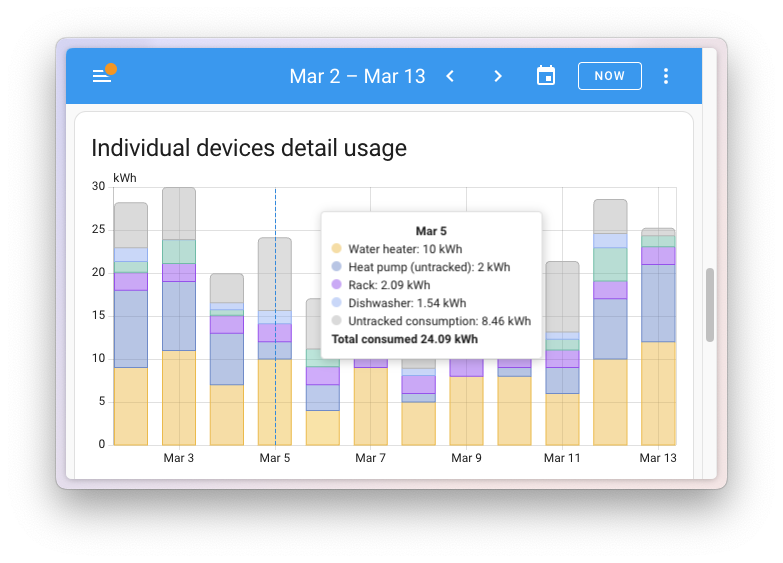
In this screenshot, the water heater is a child of the heat pump. Both report energy usage separately, but the water heater’s consumption is also included in the total reported by the heat pump. With device hierarchy enabled, Home Assistant correctly shows the usage of each device.
Awesome addition there @karwosts
Patch releases
We will also release patch releases for Home Assistant 2025.4 in April. These patch releases only contain bug fixes. Our goal is to release a patch release every Friday.
2025.4.1 - April 4
- Fix blocking event loop - daikin (@fredrike
- #141442 ) - Made Google Search enable dependent on Assist availability (@IvanLH
- #141712 ) - Fix humidifier platform for Comelit (@chemelli74
- #141854 ) - Bump evohome-async to 1.0.5 (@zxdavb
- #141871 ) - Replace “to log into” with “to log in to” in
incomfort(@NoRi2909- #142060 ) - Avoid unnecessary reload in apple_tv reauth flow (@emontnemery
- #142079 ) - Add translation for hassio update entity name (@piitaya
- #142090 ) - Bump pyenphase to 1.25.5 (@catsmanac
- #142107 ) - Hide broken ZBT-1 config entries on the hardware page (@puddly
- #142110 ) - Bump pysmhi to 1.0.1 (@gjohansson-ST
- #142111 ) - Avoid logging a warning when replacing an ignored config entry (@bdraco
- #142114 ) - Slow down polling in Tesla Fleet (@Bre77
- #142130 ) - Bump tesla-fleet-api to v1.0.17 (@Bre77
- #142131 ) - Tado bump to 0.18.11 (@erwindouna
- #142175 ) - Add preset mode to SmartThings climate (@joostlek
- #142180 ) - Do not create a HA mediaplayer for the builtin Music Assistant player (@marcelveldt
- #142192 ) - Do not fetch disconnected Home Connect appliances (@Diegorro98
- #142200 ) - Fix fibaro setup (@rappenze
- #142201 ) - Fix circular mean by always storing and using the weighted one (@edenhaus
- #142208 ) - Bump pySmartThings to 3.0.2 (@joostlek
- #142257 ) - Update frontend to 20250404.0 (@bramkragten
- #142274 ) - Bump forecast-solar lib to v4.1.0 (@klaasnicolaas
- #142280 ) - Fix skyconnect tests (@zweckj
- #142262 ) - Fix empty actions (@Petro31
- #142292 )
2025.4.2 - April 12
- Add error details in remote calendar flow (@Thomas55555
- #141753 ) - Update Roborock map more consistently on state change (@Lash-L
- #142228 ) - Add SensorDeviceClass and unit for LCN CO2 sensor. (@alengwenus
- #142320 ) - Bump opower to 0.10.0 (@tronikos
- #142321 ) - Add a description for the enable_google_search_tool option in Google AI (@tronikos
- #142322 ) - Check that the current roboorck map exists before updating it. (@Lash-L
- #142341 ) - Limit mqtt info logging for discovery of new components (@jbouwh
- #142344 ) - Bump flux_led to 1.2.0 (@bdraco
- #142362 ) - Update aioairzone to v1.0.0 (@Noltari
- #142385 ) - Only load files ending
.metadata.jsonin WebDAV (@jpbede- #142388 ) - Bump aioesphomeapi to 29.9.0 (@bdraco
- #142393 ) - Bump opower to 0.11.1 (@tronikos
- #142395 ) - Add exceptions translation to SamsungTV (@chemelli74
- #142406 ) - Add missing strings to Fritz (@chemelli74
- #142413 ) - Fix reload of AVM FRITZ!Tools when new connected device is detected (@mib1185
- #142430 ) - Fix HKC showing hvac_action as idle when fan is active and heat cool target is off (@bdraco
- #142443 ) - Fix Reolink smart AI sensors (@starkillerOG
- #142454 ) - Fix kelvin parameter in light action specifications (@epenet
- #142456 ) - Bump aioshelly to version 13.4.1 (@bieniu
- #142477 ) - Fixed Renault charge state icon (@wilfredktlr
- #142478 ) - Fix Shelly initialization if device runs large script (@bieniu
- #142487 ) - Handle None on the response candidates in Google Generative AI (@IvanLH
- #142497 ) - Fix range of Google Generative AI temperature (@tronikos
- #142513 ) - Allow max to be equal with min for mqtt number config validation (@jbouwh
- #142522 ) - Fix small typo in Music Assistant integration causing unavailable players (@marcelveldt
- #142535 ) - Fix adding devices in Husqvarna Automower (@Thomas55555
- #142549 ) - Bump pyheos to v1.0.5 (@andrewsayre
- #142554 ) - Fix Quickmode handling in ViCare integration (@CFenner
- #142561 ) - Fix Core deadlock by ensuring only one ZHA log queue handler thread is running at a time (@puddly
- #142568 ) - Fix ssl_cert load from config_flow (@fredrike
- #142570 ) - Update growatt server dependency to 1.6.0 (@thimo-seitz
- #142606 ) - Pin multidict to >= 6.4.2 to resolve memory leaks (@bdraco
- #142614 ) - Bump led_ble to 1.1.7 (@henryptung
- #142629 ) - Bump livisi to 0.0.25 (@Thomas55555
- #142638 ) - Comelit config flow timeout error (@chemelli74
- #142667 ) - Fix EC certificate key not allowed in MQTT client setup (@jbouwh
- #142698 ) - Bump PyViCare to 2.44.0 (@CFenner
- #142701 ) - Bump reolink-aio 0.13.1 (@starkillerOG
- #142719 ) - Reolink migrate unique ID debugging (@starkillerOG
- #142723 ) - Update frontend to 20250411.0 (@bramkragten
- #142736 ) - Bump pySmartThings to 3.0.4 (@joostlek
- #142739 ) - Fix SmartThings gas meter (@joostlek
- #142741 ) - Fix Anthropic bug parsing a streaming response with no json (@allenporter
- #142745 ) - Upgrade sharkiq depedency to 1.1.0 (@JeffResc
- #142746 ) - Bump ical to 9.1.0 (@Thomas55555
- #142197 ) - Add jaraco.itertools license exception as the classifier was removed but no SPDX expression was added (@sanjay900
- #142439 )
2025.4.3 - April 19
- Fix duke_energy data retrieval to adhere to service start date (@cmamatey
- #136054 ) - Check Energy Live API works before creating the coordinator in Tessie (@Bre77
- #142510 ) - Correct enum member check in home_connect (@emontnemery
- #142666 ) - Fix error in recurrence calculation of Habitica integration (@tr4nt0r
- #142759 ) - Fix MQTT device discovery when using node_id (@dionisis2014
- #142784 ) - Force Squeezebox item id to string (@peteS-UK
- #142793 ) - Keep track of last play status update time in Apple TV (@ericswpark
- #142838 ) - Select correct Reolink device uid (@starkillerOG
- #142864 ) - Fix Reolink Home Hub Pro playback (@starkillerOG
- #142871 ) - Fix quality loss for LLM conversation agent question answering (@allenporter
- #142873 ) - Only get tracked pairs for kraken (@eifinger
- #142877 ) - Bump Environment Canada library to 0.10.1 (@gwww
- #142882 ) - Bump devolo_plc_api to 1.5.1 (@Shutgun
- #142908 ) - Don’t do I/O while getting Jewish calendar data schema (@tsvi
- #142919 ) - Update UK Transport Integration URL (@AlexLamond
- #142949 ) - Bump holidays to 0.70 (@gjohansson-ST
- #142954 ) - Fix switch state for Comelit (@chemelli74
- #142978 ) - Bump reolink-aio to 0.13.2 (@starkillerOG
- #142985 ) - Increase uptime deviation for Shelly (@chemelli74
- #142996 ) - Bump pysmhi to 1.0.2 (@gjohansson-ST
- #143007 ) - Add Python-2.0 to list of approved licenses (@cdce8p
- #143052 ) - Reduce jumping Starlink uptime sensor (@frenck
- #143076 ) - Bump ZHA to 0.0.56 (@puddly
- #143165 ) - Fix SmartThings soundbar without media playback (@joostlek
- #143170 ) - Fix missing binary sensor for CoolSelect+ in SmartThings (@joostlek
- #143216 )
2025.4.4 - April 25
- Meteofrance: adding new states provided by MF API since mid April (@vingerha
- #143137 ) - Create Home Connect active and selected program entities only when there are programs (@Diegorro98
- #143185 ) - Météo-France: Additional states and change weather condition for “Ciel clair” (@vingerha
- #143198 ) - Update setuptools to 78.1.1 (@cdce8p
- #143275 ) - Fix licenses check for setuptools (@cdce8p
- #143292 ) - Add scan interval and parallel updates to LinkPlay media player (@silamon
- #143324 ) - Sync random sensor device classes (@silamon
- #143368 ) - Fix Vodafone Station config entry unload (@chemelli74
- #143371 ) - Bump aiohomekit to 3.2.14 (@bdraco
- #143440 ) - Bump dio-chacon-api to v1.2.2 (@cnico
- #143489 ) - Bump pysmartthings to 3.0.5 (@joostlek
- #143586 )
Need help? Join the community!
Home Assistant has a great community of users who are all more than willing to help each other out. So, join us!
Our very active Discord chat server is an excellent place to be at, and don’t forget to join our amazing forums.
Found a bug or issue? Please report it in our issue tracker
Are you more into email? Sign-up for our Building the Open Home Newsletter to get the latest news about features, things happening in our community and other news about building an Open Home; straight into your inbox.
Backward-incompatible changes
We do our best to avoid making changes to existing functionality that might unexpectedly impact your Home Assistant installation. Unfortunately, sometimes, it is inevitable.
We always make sure to document these changes to make the transition as easy as possible for you. This release has the following backward-incompatible changes:
Automation & script variable scopes
The variables action is no longer restricted to local scopes; it can now
update the value of a variable also in outer scopes. If the variable was not
previously defined, it will be created in the top-level (script run) scope.
actions:
- variables:
x: 1
y: 1
- sequence:
- variables:
y: 2 # Updates y, which exists in the outer scope
z: 2 # Since z is not defined yet, it is assigned in the top-level scope
- action: persistent_notification.create
data:
message: ", , " # x=1, y=2, z=2
# Note: previously, it would be: x=1, y=1, z undefined
If you have automations or scripts that use the same variable name in different (previously isolated) scopes, you will need to update them: simply use distinct variable names to prevent any conflicts.
(@arturpragacz
Jewish Calendar
Holiday sensor changes:
- In Israel, “Simchat Torah” is now “Shmini Atzeret, Simchat Torah”
- In Israel, the 30th of Shvat returns “Family Day, Rosh Chodesh”
Additionally, the type_id has been removed from the state attributes, use
the type if needed instead.
(@tsvi
Persistent notifications
Persistent notifications with notification_id config_entry_reconfigure are
no longer created when an integration fails to authenticate.
Automations triggering on such persistent notifications
will thus no longer work.
(@emontnemery
Reolink
The Reolink password is now limited to 31 characters. The latest versions of the Reolink app and desktop client also have this 31-character limit. If you configured your Reolink password years ago, it is possible it is longer than 31 characters. In that case you will get a reauthentication flow asking you to change the password. Passwords longer than 31 characters can cause issues in the latest Reolink API.
If you are a custom integration developer and want to learn about changes and new features available for your integration: Be sure to follow our developer blog. The following changes are the most notable for this release:
All changes
Of course there is a lot more in this release. You can find a list of all changes made here: Full changelog for Home Assistant Core 2025.4